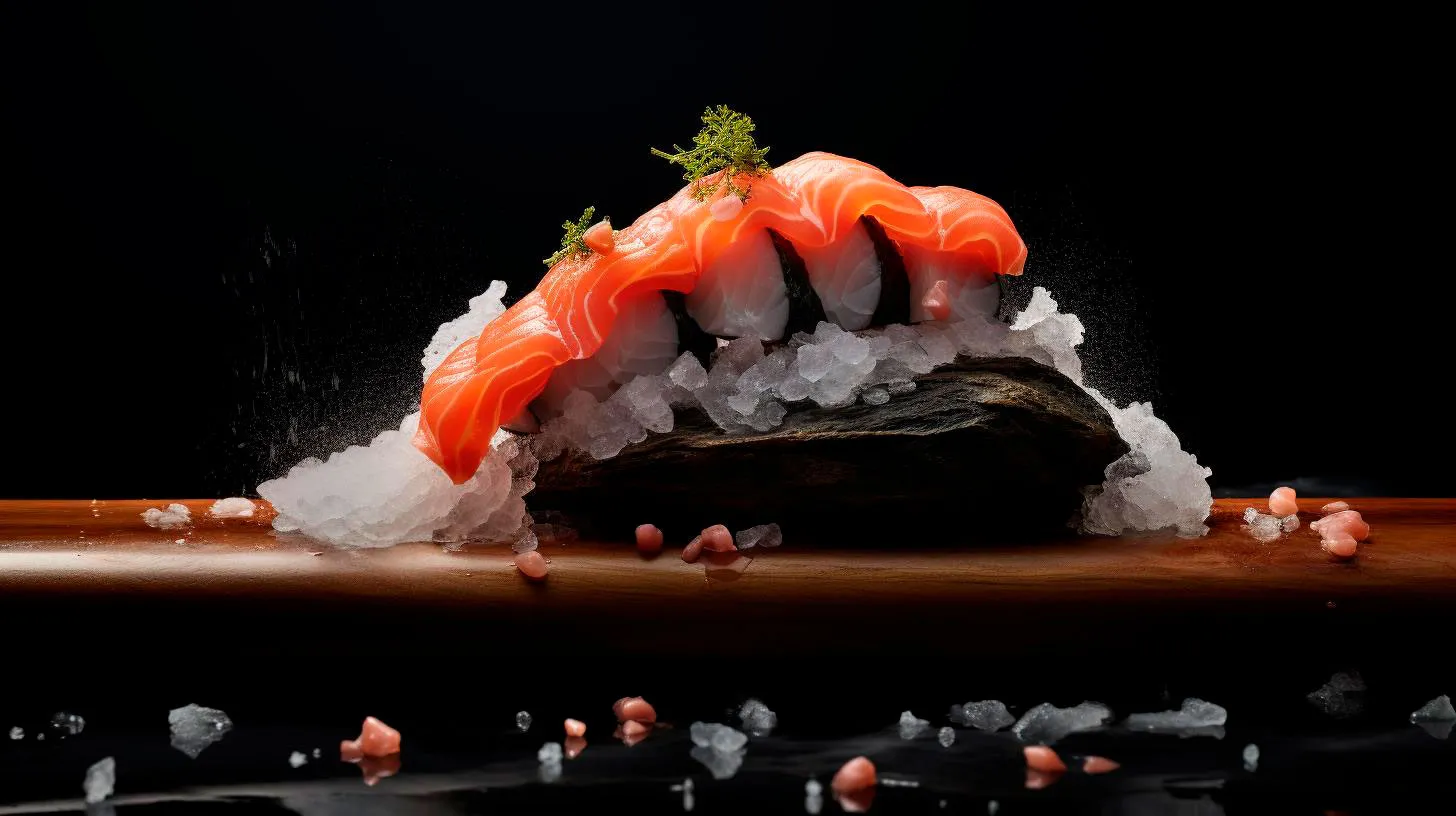Why Pickled Ginger Matters
In this article, we will explore why pickled ginger matters and why it deserves a place in your pantry. So, let’s dive right in!
The Flavorful Journey
Pickled ginger carries a distinct flavor profile that combines sweetness, sharpness, and tanginess. Made from young ginger roots that are thinly sliced and soaked in a mixture of vinegar, sugar, and salt, pickled ginger adds a delightful burst of flavor to any dish. Its refreshing and zesty taste acts as a palate cleanser, making it an ideal companion to sushi rolls and sashimi dishes.
Key Takeaway:
- Pickled ginger offers a unique flavor profile combining sweetness, sharpness, and tanginess.
- Its refreshing taste acts as a palate cleanser between bites to enhance the overall dining experience.
A Nutritional Powerhouse
Apart from being a flavor enhancer, pickled ginger is also rich in beneficial nutrients. It contains vitamins B6 and C, as well as minerals like potassium and magnesium. These nutrients contribute to maintaining a healthy immune system, improving digestion, and supporting heart health. Additionally, ginger is known for its anti-inflammatory properties and can aid in reducing nausea and soothing an upset stomach.
Key Takeaway:
- Pickled ginger is packed with essential vitamins and minerals that promote overall health and well-being.
- The anti-inflammatory properties of ginger make it a natural remedy for digestive issues and nausea.
Boosts Digestion and Nutrition Absorption
One of the standout benefits of pickled ginger is its ability to aid digestion. Ginger contains a bioactive compound called gingerol that helps stimulate the production of digestive enzymes, facilitating the breakdown of food. It also supports the absorption of nutrients, ensuring that your body receives all the goodness from the food you consume. By incorporating pickled ginger into your meals, you can promote a healthier digestive system.
Key Takeaway:
- The presence of gingerol in pickled ginger aids digestion by stimulating the production of digestive enzymes.
- It supports nutrient absorption, ensuring that your body receives maximum nutrition from the food you eat.
Join the Anti-cancer Crusade
Pickled ginger contains unique compounds with potential anti-cancer properties. Studies have shown that gingerols present in ginger possess antioxidant and anti-inflammatory effects, which may contribute to reducing the risk of certain types of cancer. Furthermore, ginger can help alleviate chemotherapy-induced nausea, making it a beneficial addition to the diet of cancer patients.
Key Takeaway:
- The antioxidant and anti-inflammatory effects of gingerols make pickled ginger a potential ally in reducing the risk of cancer.
- It can also help in managing nausea caused by chemotherapy.
A Versatile Pantry Staple
Pickled ginger is not limited to being a sushi garnish; it can be a versatile ingredient in numerous dishes. Its tangy flavor can enhance marinades, dressings, stir-fries, and Asian-style salads. Additionally, pickled ginger can bring a unique twist to non-Asian recipes, lending an exciting flavor to sandwiches, wraps, and even cocktails. Its versatility makes it a must-have condiment that can elevate a wide range of culinary creations.
Key Takeaway:
- Pickled ginger’s tangy flavor makes it a versatile ingredient that can be used in various cuisines and recipes.
- From dressings and marinades to sandwiches and cocktails, pickled ginger can add a distinctive twist to any dish.
In conclusion, the inclusion of pickled ginger in your diet not only adds a burst of flavor to your meals but also contributes to a healthier you. From its unique taste to its potential health benefits, pickled ginger offers much more than just being an accompaniment to sushi. So, why not explore the diverse culinary possibilities and embrace the numerous advantages of this vibrant and flavorful ingredient today?
The Key to Authentic Sushi
The Importance of Freshness
When it comes to sushi, freshness is paramount. The quality of the fish and other ingredients used can make or break the taste of the final dish. Unlike other types of cuisine, sushi is typically served raw, so the ingredients must be of the highest quality to ensure both safety and taste.
Key Takeaway: Freshness is the foundation of authentic sushi. Using the freshest fish and ingredients results in a flavorful, melt-in-your-mouth experience.
The Art of Sushi Rice
While the fish often takes the spotlight in sushi, the rice plays an equally crucial role. Sushi rice, also known as shari, is a special variety of Japanese rice that is seasoned with rice vinegar, sugar, and salt. The proper preparation and seasoning of the rice are essential to achieve the right texture and balance of flavors.
Key Takeaway: The expertise in preparing sushi rice, from its delicate texture to its subtle flavors, is what sets authentic sushi apart from imitations.
Knife Skills and Precision
The art of making sushi requires impeccable knife skills and precision. Sushi chefs undergo years of training to master the art of slicing and shaping the fish with utmost care. Each cut is made with intention to enhance the texture and presentation of the sushi.
Key Takeaway: The precision and skill of the sushi chef play a crucial role in creating visually appealing and mouthwatering sushi.
The Role of Seasonality
In traditional Japanese cuisine, seasonality is highly regarded. Authentic sushi embraces this concept by highlighting the flavors and ingredients that are in season. By using seasonal ingredients, sushi chefs can create dishes that are not only fresher but also showcase the best flavors each season has to offer.
Key Takeaway: Embracing seasonality allows for a diverse sushi experience and ensures the freshest possible ingredients are used in each dish.
The Harmony of Umami
Umami, the fifth taste sensation, is a cornerstone of authentic Japanese cuisine, and sushi is no exception. A delicate balance of umami flavors is achieved through carefully chosen ingredients, such as soy sauce, seaweed, and fermented fish flavors like miso and sake. This balance of flavors is what elevates sushi to a culinary masterpiece.
Key Takeaway: The harmony of umami flavors in authentic sushi creates a satisfying and unique eating experience that keeps you coming back for more.
Health Benefits
In addition to its exquisite taste, authentic sushi offers numerous health benefits. Here are a few ways sushi can contribute to a healthy lifestyle:
- Rich in Omega-3 fatty acids, which are beneficial for heart health.
- High in protein, which supports muscle growth and repair.
- Contains important minerals, such as iodine, which is essential for a healthy thyroid function.
- Low in saturated fats and calories compared to many other types of cuisine.
Key Takeaway: Enjoying authentic sushi not only satisfies your taste buds but also promotes a healthy lifestyle.
In Conclusion
Authentic sushi is a culinary art that requires a deep understanding of its key components. From the freshness of the ingredients to the precision of knife skills, every detail matters. By appreciating the craftsmanship and embracing the flavors, you can truly experience the magic of authentic sushi. So, the next time you indulge in a plate of sushi, remember the key to its authenticity lies in the mastery and passion behind every bite.
Unveiling the Secrets of Sushi Rice
But what makes sushi rice so special? How does it differ from regular rice? In this article, we will delve into the mysteries of sushi rice, uncovering its secrets and exploring why it holds such significance in the art of sushi making.
The Basics of Sushi Rice
Unlike ordinary rice, sushi rice is meticulously prepared to achieve its distinctive texture and flavor. The key lies in the combination of vinegar, salt, and sugar that is carefully mixed into the rice once it is cooked.
Here are some essential characteristics and techniques that define sushi rice:
- Short-grain Rice: Sushi rice is typically made using short-grain rice, which has a higher starch content. This gives the rice its desired sticky and chewy texture.
- Vinegar Seasoning: The addition of rice vinegar, salt, and sugar creates the unique tangy flavor that complements the other ingredients in sushi rolls.
- Proper Washing: Before cooking, it’s crucial to wash the rice multiple times to remove excess starch and achieve the desired texture.
- Cooking Technique: Sushi rice is traditionally prepared using a specific cooking technique that involves both steaming and simmering to achieve the perfect texture.
- Mixing with Seasoning: Once the rice is cooked, it is gently mixed with the vinegar seasoning using a cutting motion to prevent crushing the grains.
The Secrets to Perfect Sushi Rice
Now that we understand the basics, let’s unveil some secrets to achieving the perfect sushi rice:
- Quality of Rice: Using high-quality short-grain rice, like Japanese sushi rice, is essential to achieve the desired taste and texture.
- Proportions: The right balance of vinegar, salt, and sugar is crucial. Generally, a ratio of 1:1:1.5 (vinegar:salt:sugar) is used, but it can be adjusted to personal preference.
- Seasoning Technique: Mix the vinegar seasoning gently into the rice using a cutting motion, ensuring the rice is evenly coated.
- Cooling and Handling: Once seasoned, the rice should be cooled quickly using a fan or by gently fanning it with a flat utensil. It should be handled with care to prevent crushing or overmixing, preserving the texture.
The Significance of Sushi Rice
Why does sushi rice play such a crucial role in sushi? Here are some key takeaways:
- Texture: The stickiness of sushi rice allows it to hold together, creating a firm base for the delicate toppings and fillings.
- Flavor Enhancement: The vinegar seasoning not only adds a tangy taste but also enhances the overall flavors of the sushi roll, balancing the richness of fish and other ingredients.
- Aesthetic Appeal: Properly seasoned sushi rice has an elegant sheen and a glossy finish, adding to the visual appeal of the sushi rolls.
Sushi rice is not only crucial for traditional sushi rolls but also forms the foundation for other sushi variations like nigiri and chirashi. Whether you are a sushi aficionado or a curious food lover, understanding the secrets of sushi rice elevates your appreciation for this iconic Japanese dish.
Now that the secrets of sushi rice have been unveiled, it’s time to put your knowledge to the test and embark on a sushi-making adventure in your own kitchen. Experiment with different ingredients, create your own flavor combinations, and let your culinary creativity shine!
Mastering the Art of Sashimi Selection
Here are some key points to consider when it comes to selecting the perfect sashimi:
1. Freshness is Paramount
The quality of the fish used for sashimi is of utmost importance. Freshness directly affects the taste and texture of the dish. Look for these characteristics to ensure freshness:
- Bright, clear eyes: Fish with bright, clear eyes are a good indication of freshness.
- Red gills: The gills of the fish should be vibrant red, indicating that it is in peak condition.
- Firm flesh: Gently press the fish with your finger – it should feel firm, not mushy.
- Minimal odor: Fresh fish should have a pleasant, briny scent, not a strong fishy smell.
Remember, freshness is the key to a delicious sashimi experience.
2. Seasonality Matters
Just like produce, fish has its own seasons. Each type of fish has a specific time of year when it is at its peak flavor. By choosing fish that are in-season, you ensure that you are getting the best taste and quality. Here are a few examples:
- Tuna: Best in the late fall and winter
- Salmon: Peak season is summer
- Yellowtail: Winter is the ideal time for this fish
Choosing fish that are in-season also helps support sustainable fishing practices and reduces the environmental impact.
3. Know Your Preferred Taste and Texture
Sashimi offers a wide range of flavors and textures, catering to different palates. Here are a few popular options:
- Toro (Fatty Tuna): For a melt-in-your-mouth experience
- Hamachi (Yellowtail): Delicate and buttery
- Sake (Salmon): Rich and buttery with a hint of sweetness
- Hirame (Flounder): Delicate and mild in flavor
- Ika (Squid): Firm, slightly chewy texture with a subtle sweetness
Understanding your preferred taste and texture will help you make the best sashimi selection each time you indulge.
4. Presentation and Plating
When it comes to sashimi, presentation is key. The aesthetic appeal of the dish enhances the overall dining experience. Here are a few tips for a visually stunning sashimi presentation:
- Vibrant colors: Choose fish that have bright, eye-catching colors.
- Contrasting textures: Combine fish with different textures to create visual interest.
- Garnishes: Add complementary garnishes like fresh herbs, edible flowers, or a sprinkle of sesame seeds.
- Accompaniments: Serve sashimi with pickled ginger, wasabi, and soy sauce on the side.
Remember, the eyes eat first, so take the time to create a visually pleasing plate of sashimi.
Key Takeaways
Mastering the art of sashimi selection takes practice, but the effort is well worth it for any sushi enthusiast. Remember these key takeaways:
- Freshness is crucial for a delicious sashimi experience.
- Choose fish that are in-season for optimal flavor and sustainability.
- Understand your preferred taste and texture to enhance your enjoyment.
- Create visually stunning plates by considering colors, textures, and garnishes.
Now that you have the knowledge, it’s time to embark on your journey to sashimi mastery. Explore different fish varieties, savor the delicate flavors, and enjoy the unique experience that sashimi brings.


